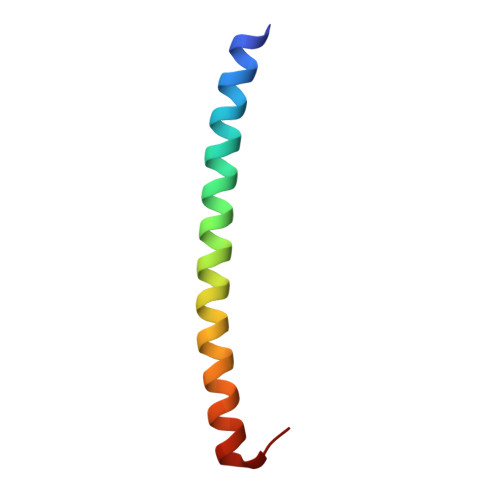Structural destabilization of tropomyosin induced by the cardiomyopathy-linked mutation R21H.
Ly, T., Krieger, I., Tolkatchev, D., Krone, C., Moural, T., Samatey, F.A., Kang, C., Kostyukova, A.S.(2018) Protein Sci 27: 498-508
- PubMed: 29105867
- DOI: https://doi.org/10.1002/pro.3341
- Primary Citation of Related Structures:
5KHT - PubMed Abstract:
The missense mutation R21H in striated muscle tropomyosin is associated with hypertrophic cardiomyopathy, a genetic cardiac disease and a leading cause of sudden cardiac death in young people. Tropomyosin adopts conformation of a coiled coil which is critical for regulation of muscle contraction. In this study, we investigated the effects of the R21H mutation on the coiled-coil structure of tropomyosin and its interactions with its binding partners, tropomodulin and leiomodin. Using circular dichroism and isothermal titration calorimetry, we found that the mutation profoundly destabilized the structural integrity of αTM1a 1-28 Zip, a chimeric peptide containing the first 28 residues of tropomyosin. The mutated αTM1a 1-28 Zip was still able to interact with tropomodulin and leiomodin. However, the mutation resulted in a ∼30-fold decrease of αTM1a 1-28 Zip's binding affinity to leiomodin. We used a crystal structure of αTM1a 1-28 Zip that we solved at 1.5 Å resolution to study the mutation's effect in silico by means of molecular dynamics simulation. The simulation data indicated that while the mutation disrupted αTM1a 1-28 Zip's coiled-coil structure, most notably from residue Ala18 to residue His31, it may not affect the N-terminal end of tropomyosin. The drastic decrease of αTM1a 1-28 Zip's affinity to leiomodin caused by the mutation may lead to changes in the dynamics at the pointed end of thin filaments. Therefore, the R21H mutation is likely interfering with the regulation of the normal thin filament length essential for proper muscle contraction.
Organizational Affiliation:
Voiland School of Chemical Engineering and Bioengineering, Washington State University, Pullman, Washington.















